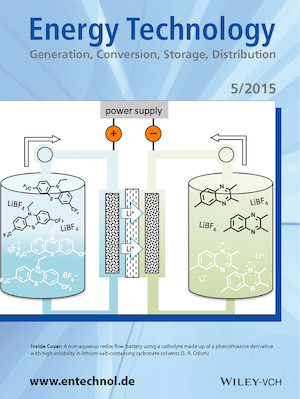 Inside Cover: A Highly Soluble Organic Catholyte for Non-Aqueous Redox Flow Batteries (Energy Technol. 5/2015)
Inside Cover: A Highly Soluble Organic Catholyte for Non-Aqueous Redox Flow Batteries (Energy Technol. 5/2015)
Redox Flow Batteries worth their Salt: Our current electrical grid is predicted to become unstable if solar and wind power rise to supply more than 20 % of its energy—the amount that we are predicted to reach by 2030—because the grid lacks the ability to accommodate fluctuating energy sources. To remedy this limitation, large-scale electrical energy storage (EES) systems have been investigated for the purpose of storing energy during peak production and releasing it to relieve strain on the grid during periods of peak end-user demand, resulting in a load-leveling effect. For grid storage using EES, aqueous redox flow batteries (RFBs) have shown great promise due to their low costs and long lifetime and have been demonstrated on scales of up to 10 MW. In the Communication on page 476 from Susan A. Odom and colleagues from the University of Kentucky, a phenothiazine derivative with high solubility in carbonate solvents containing lithium salts shows extensive overcharge protection and, as a result, is evaluated as a catholyte for non-aqueous redox flow batteries. The authors report the testing of 3,7-bis(trifluoromethyl)-N-ethylphenothiazine as a catholyte and 2,3,6-trimethylquinoxaline as the anolyte in redox flow batteries containing 0.05, 0.15, and 0.35 m active material and found the longest capacity retention over approximately 60 cycles at 0.15 m. To our knowledge, this is the most soluble catholyte candidate with a robust radical cation.




